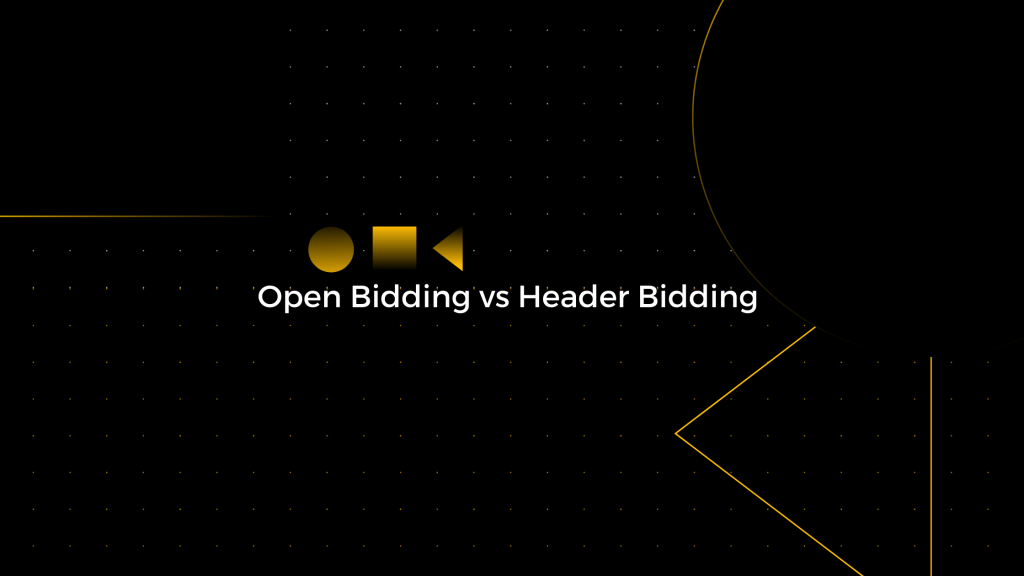Header bidding has become the buzzword of the last few years and its widespread adoption by the ad tech world means there’s a reason for that. It maximizes demand competition for every ad impression and boosts revenues. Soon after header bidding’s rise, Google introduced Exchange Bidding, or EBDA (Exchange Bidding in Dynamic Allocation). It was meant as an alternative to header bidding that required much less publisher involvement. Today, Google’s product is known as Open Bidding. In this article, we’ll take a look at both header bidding and Open Bidding, how they compare to each other, and how publishers can decide which one to use.

What is Header Bidding?
A technology that allows multiple ad exchanges to simultaneously bid on the publisher’s ad inventory before a call to the ad server. It can be implemented client-side (i.e. browser-side), and/or server-side. Both ways have their pros and cons, but the main goal is to reach a larger number of demand sources than with the traditional waterfall method and hold the auctions in a transparent and efficient way. Today, publishers can choose from multiple header bidding demand partners and use open-source, proprietary, or managed wrappers to streamline the process. Chances are, if you’re monetizing your website, you are using header bidding or considering it.
Naturally, with header bidding’s adoption getting wider and wider, Google had to offer its own version. Enter Exchange Bidding in Dynamic Allocation (EBDA). Now known as Open Bidding.
What is Open Bidding?
Open bidding is Google’s server-to-server technology that allows publishers to invite multiple third-party ad exchanges in an auction for their inventory. The bidding happens in real-time and the demand partners compete on a first price basis against Google’s Ad Manager line items in so-called dynamic allocation. But what is dynamic allocation? Simply put, this is the term that Google uses for the automatic process that allows “all non-guaranteed demand — Open Auction, Open Bidding, and remnant line items — to compete in real-time with guaranteed line items.”* This increases the competition for your inventory and should result in higher yield without an effect on user experience. The whole process is managed via Google’s Ad Manager, so implementation is simple and straightforward. The server-to-server connection used for the auction means that the bidding happens within Google’s ad server and not on the user’s browser.
Even though both technologies aim at the same result – increasing the competition and maximizing yield, they achieve it in different ways and thus have their own set of pros and cons. Let’s look at Open Bidding’s advantages and disadvantages compared to header bidding.
Advantages of Open Bidding
Prevent Page Latency
Open Bidding is executed via server-to-server connection and this means that the auction happens at the ad server, as opposed to client-side header bidding where it takes place in the user’s browser. This translates to much lower latency and better user experience, especially on mobile.
Simple Implementation and Operation
Open Bidding is implemented and managed via Google’s Ad Manager. Unlike header bidding, which usually requires a complicated custom setup with multiple line items and regular monitoring, open bidding does not call for additional technical involvement.
Fast Unified Payments
Regardless of the number of third-party exchanges participating in the Open Bidding auction, publishers get paid once, by Google, at net of 30 days, which can be quite attractive in terms of operational cash flow availability. Furthermore, the bid discrepancies that are quite common in ad tech, are eliminated with Google doing the billing, meaning one less thing to worry about.
Disadvantages of Open Bidding
Open Bidding is a server-to-server technology and comes with the typical downsides of server-side header bidding:
Cookie Matching
With client-side header bidding information about the users is available to advertisers via the browser cookies and allows them to better match their ads and respectively be willing to place higher bids. With Open Bidding, however, some of the information is lost in between servers, which can result in lower CPMs.
Transparency
Header bidding was designed to create more competition to Google AdX and increase transparency in the bidding process. It provides publishers with full control over the auction setup and access to all the bidding data. In contrast, Open Bidding does not have this level of visibility and as a product of Google, it remains sort of a “black box” to publishers.
Besides the disadvantages of Open Bidding that come from its server-to-server nature, there is another caveat that is due to the prerequisites to its use.
Ease of Access
In order to use Open Bidding, a publisher must have an Ad Exchange account linked to Google Ad Manager and sign an Open Bidding addendum to their contract. Whereas header bidding is available to anyone with open-source solutions such as Prebid.
So which one should you use?
As with most things in programmatic, there is no hard and fast or black and white answer. Not one solution is better than the other, they only offer different roads to the same destination. The truth is a combination of the two strategies is possible and might as well be the right fit. Your choice would depend on your technical capabilities, whether you place more importance on transparency, latency, or control. What is necessary is testing and isolation of inventory and line items to confirm the best combination and setup for your particular inventory, goals, and preferences.

